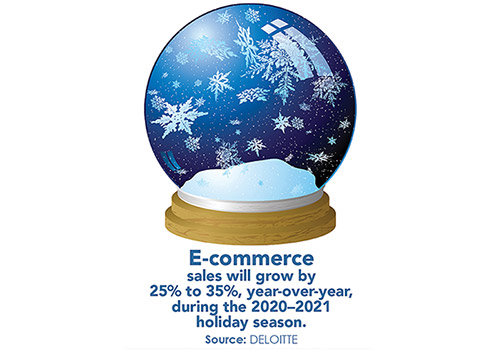This significant growth in online sales shows no signs of slowing, with Deloitte forecasting e-commerce sales to increase by 25–35 percent year-over-year during this upcoming holiday season, compared to an increase of 14.7 percent in 2019. Retailers and shippers cannot deliver on these demands unless the broadest selection of inventory is positioned close to significant populations. It all boils down to having the right inventory in the right places at the right time.
Nothing happens on the shop floor, whether digital or physical, that doesn’t have an impact on the supply chain. Ever-changing consumer behaviors mean real estate and supply chain professionals must make quick decisions during a time when nearly every aspect of the industry is in flux. Everything from network planning and building size to labor and automation is changing — not to mention the expectation of free and faster shipping.

Planning for real estate expansion into new logistics facilities has never been more challenging. Even before the virus wreaked havoc across the globe, fundamentals including a near-historically-low vacancy rate of 5 percent in Q1 2020, upward pressure on rents, and increased demand for quality space created barriers for real estate decision-makers. Add in pandemic-driven disruptions and peak holiday shopping season and you have a recipe for never-before-seen demand for last-mile delivery stations and fulfillment centers.
Nothing happens on the shop floor, whether digital or physical, that doesn’t have an impact on the supply chain. The logistics and industrial asset class is the only real estate sector to remain resilient during the pandemic. The industrial sector has managed to see over 159 million square feet of positive absorption year-to-date, putting the market on pace to surpass 200 million square feet of positive absorption for the seventh consecutive year.
Investment activity is still reasonably high, with a range of large institutions and REITs continuing active investment in industrial product since the pandemic began, with most of the top buyers of industrial real estate closing deals in multiple months across multiple geographies. Although industrial sales are down year-over-year, investment activity is in line with 2017 levels, which at the time was considered a very liquid market. The same cannot be said for any other product type.
Industrial has been a top performing asset type since 2016 and is expected to continue. The most recent ULI survey expects industrial to post 4.5 percent positive returns in 2020 accelerating to 10 percent by 2022. This compares to an overall total return forecast for all property types of -1.7 percent in 2020 and 5.6 percent in 2022.
Location and Labor
It takes more than a well-designed building to make a logistics facility successful. The search for an ideal logistics location requires an intricate balance between location and labor availability. You need to be close to the consumer to facilitate fast delivery, but also in a location that provides a qualified and sustainable employee pool.
E-commerce orders are fulfilled differently than wholesale or traditional store replenishment. Rather than being palletized, orders are shipped as “eaches,” which are received, stowed, picked, and shipped individually. This process requires a greater number of associates than comparable legacy warehouses.
When searching for a location, it’s important to weigh all the factors. A proper labor analysis digs into employee drive-times, extent of existing warehouse jobs, turnover, number of eligible workers, unemployment and wage rate trends. It’s also vital to consider labor availability for peak season. It’s common for large e-commerce facilities to see hiring needs double to support peak holiday shopping season — the most critical time of the year for most players — leaving no margin for error in underwriting labor.
Why Not Automate?
With labor sometimes in short supply, automation is often a consideration. However, the trade-off between automation and labor is a huge business decision. The initial capital investment to implement automation can be massive. Also, automation or robotics can make scaling operations for peak season difficult because it locks operations into a specific process flow. This can result in a loss of agility to adjust for future throughput shifts.
The logistics and industrial asset class is the only real estate sector to remain resilient during the pandemic. Every e-commerce retailer or fulfillment operator must land on which lane is a better fit for current (and future) operations. The math differs based on the nature of the items fulfilled, the delivery level of service, availability of capital, and variability in throughput. And having more automation doesn’t always equal a smaller labor force because it doesn’t necessarily replace human labor, rather it works alongside associates to make jobs safer and more productive. Automation also requires workers to perform maintenance, coding, and other tasks to keep the machines running smoothly.
“Last-Mile” Hurdles
With consumers expecting ever-faster delivery speeds, e-commerce players must weave operations deeper into urban and suburban areas. These so-called last-mile facilities are where the packages are sorted and loaded into vans or other vehicles for the last leg of the delivery journey. Recent trends in e-commerce have turned a marathon into a sprint to locate these types of infill facilities.
Infill and suburban logistics locations face several hurdles. The two biggest are finding an existing building with the right functionality or a redevelopment site with the right potential and obtaining community support (and zoning) to allow the extra traffic counts and noise that may be created by delivery vehicles.
E-commerce players must weave operations deeper into urban and suburban areas. When it comes to building layout, a last-mile facility doesn’t commonly require a lot of dock doors and clear height. Among key requirements are extensive parking areas for associates and vans, and a huge vehicle staging and loading room.
There has been a lot of buzz about the potential to convert vacant retail space into logistics or last-mile facilities. The challenges, however, can be significant due to building conversion costs, site layout, and other retailers and community NIMBY (not in my back yard) objections. Prologis estimates that retail-to-logistics conversions could amount to 5-10 million square feet per year resulting in 50–100 million square feet over the next decade. This equates to less than 1 percent of all existing logistics real estate and less than 3 percent of typical annual new construction of logistics real estate in the top 25 U.S. markets. To date there has been more chatter than execution of this strategy. Significant capital is exploring such conversions, but any measure of success remains to be seen.
With Demand Comes Opportunity
Demand for a variety of logistics facilities will continue to surge with the accelerated penetration of e-commerce providing in-roads for investors and developers to build on. We need only look at our own shopping patterns to see why. Still, challenges remain for retail, supply chain, and real estate professionals when solving the logistical puzzle created by the current-day consumer.


